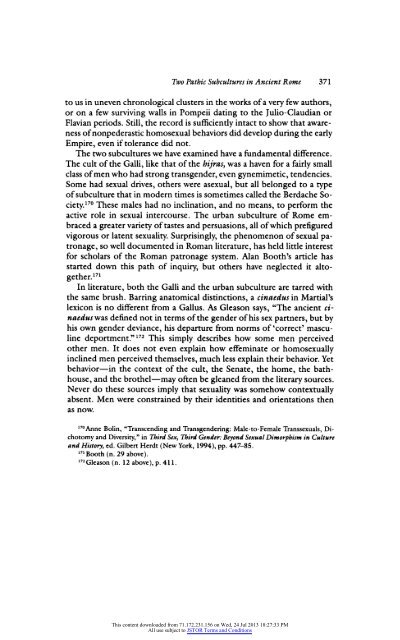Two Pathic Subcultures in Ancient Rome
Two Pathic Subcultures in Ancient Rome
Two Pathic Subcultures in Ancient Rome
Create successful ePaper yourself
Turn your PDF publications into a flip-book with our unique Google optimized e-Paper software.
<strong>Two</strong> <strong>Pathic</strong> <strong>Subcultures</strong> <strong>in</strong> <strong>Ancient</strong> <strong>Rome</strong> 371<br />
to us <strong>in</strong> uneven chronological clusters <strong>in</strong> the works of a very few authors,<br />
or on a few surviv<strong>in</strong>g walls <strong>in</strong> Pompeii dat<strong>in</strong>g to the Julio-Claudian or<br />
Flavian periods. Still, the record is sufficiently <strong>in</strong>tact to show that awareness<br />
of nonpederastic homosexual behaviors did develop dur<strong>in</strong>g the early<br />
Empire, even if tolerance did not.<br />
The two subcultures we have exam<strong>in</strong>ed have a fundamental difference.<br />
The cult of the Galli, like that of the hijras, was a haven for a fairly small<br />
class of men who had strong transgender, even gynemimetic, tendencies.<br />
Some had sexual drives, others were asexual, but all belonged to a type<br />
of subculture that <strong>in</strong> modern times is sometimes called the Berdache Society.'70<br />
These males had no <strong>in</strong>cl<strong>in</strong>ation, and no means, to perform the<br />
active role <strong>in</strong> sexual <strong>in</strong>tercourse. The urban subculture of <strong>Rome</strong> embraced<br />
a greater variety of tastes and persuasions, all of which prefigured<br />
vigorous or latent sexuality. Surpris<strong>in</strong>gly, the phenomenon of sexual patronage,<br />
so well documented <strong>in</strong> Roman literature, has held little <strong>in</strong>terest<br />
for scholars of the Roman patronage system. Alan Booth's article has<br />
started down this path of <strong>in</strong>quiry, but others have neglected it altogether.<br />
171<br />
In literature, both the Galli and the urban subculture are tarred with<br />
the same brush. Barr<strong>in</strong>g anatomical dist<strong>in</strong>ctions, a c<strong>in</strong>aedus <strong>in</strong> Martial's<br />
lexicon is no different from a Gallus. As Gleason says, "The ancient c<strong>in</strong>aedus<br />
was def<strong>in</strong>ed not <strong>in</strong> terms of the gender of his sex partners, but by<br />
his own gender deviance, his departure from norms of 'correct' mascul<strong>in</strong>e<br />
deportment."'72 This simply describes how some men perceived<br />
other men. It does not even expla<strong>in</strong> how effem<strong>in</strong>ate or homosexually<br />
<strong>in</strong>cl<strong>in</strong>ed men perceived themselves, much less expla<strong>in</strong> their behavior. Yet<br />
behavior-<strong>in</strong> the context of the cult, the Senate, the home, the bathhouse,<br />
and the brothel-may often be gleaned from the literary sources.<br />
Never do these sources imply that sexuality was somehow contextually<br />
absent. Men were constra<strong>in</strong>ed by their identities and orientations then<br />
as now.<br />
'70Anne Bol<strong>in</strong>, "Transcend<strong>in</strong>g and Transgender<strong>in</strong>g: Male-to-Female Transsexuals, Dichotomy<br />
and Diversity," <strong>in</strong> Third Sex, Third Gender: Beyond Sexual Dimorphism <strong>in</strong> Culture<br />
and History, ed. Gilbert Herdt (New York, 1994), pp. 447-85.<br />
'17 Booth (n. 29 above).<br />
172<br />
Gleason (n. 12 above), p. 41 1.<br />
This content downloaded from 71.172.231.156 on Wed, 24 Jul 2013 18:27:33 PM<br />
All use subject to JSTOR Terms and Conditions
















